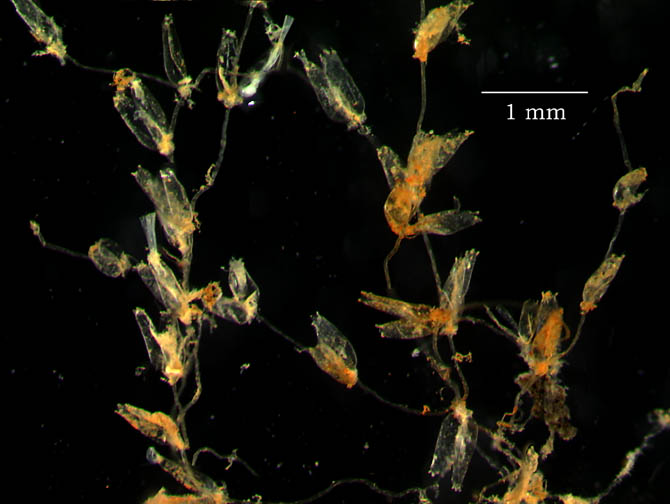Invasion History
First Non-native North American Tidal Record: 2001First Non-native West Coast Tidal Record: 2001
First Non-native East/Gulf Coast Tidal Record:
General Invasion History:
Aeverrillia armata was first described from Vineyard Sound, Massachusetts by Verrill in 1873. Its native range extends from Mount Desert Island, Maine to North Carolina (Maturo 1958), the Gulf Coast of Florida (Shier 1964), and Galveston Bay and Corpus Christi, Texas (Ruiz et al. unpublished data). It has also been reported from the Bay of Antonina, Brazil, where we consider it cryptogenic (Marcus 1941, cited by Winston 1977). In 2001, it was collected in San Francisco Bay, California and specimens were found in New Zealand in the 1960s.
North American Invasion History:
Invasion History on the West Coast:
In 2001, Aeverrillia armata was collected in San Francisco Bay, California, near Pacific Bell Park in the central bay. It was collected on a bottom of mud and shell fragments, using a Petersen Grab (California Academy of Natural Sciences 2005, http://research.calacademy.org/redirect?url=http://researcharchive.calacademy.org/research/izg/SFBay2K/Aeverrillia%20armata.htm).
Invasion History Elsewhere in the World:
In the Pacific Ocean, Aeverrillia armata was collected on the North Island of New Zealand near Auckland in 1967 and 1968, but has not been seen since (Gordon and Mawatari 1992).
Description
Aeverrillia armata is an encrusting, branched, uncalcified bryozoan. Paired zooids branch from a slender, segmented stolon, entwined and creeping on the substrate. Its zooids are oval and elongate, ranging from 0.55-0.65 mm tall, and 0.175 mm in diameter. The zooids are widest at their base and flattened on the side facing the stolon. Each of the four distal corners of the zooecia bears a thin spine, arising from a short prominence. A pleated collar, bearing setae, rises around the lophophore, 'like an Elizabethan ruff'. Colonies reach 5-6 cm in length. The body color is transparent to yellowish (description from: Osburn 1944; Rogick and Croasdale 1949; Maturo 1957; Gordon and Mawatari 1992; Winston and Hayward 2012).
Taxonomy
Taxonomic Tree
| Kingdom: | Animalia | |
| Phylum: | Bryozoa | |
| Class: | Gymnolaemata | |
| Order: | Ctenostomata | |
| Suborder: | Stolonifera | |
| Family: | Walkeriidae | |
| Genus: | Aeverrillia | |
| Species: | armata |
Synonyms
Buskia armata (Osburn, 1933)
Hippuraria armata (Osburn, 1912)
Vesicularia armata (Verrill, 1874)
Potentially Misidentified Species
None
Ecology
General:
Life History- Aeverrillia armata is a vine-like to bushy, soft-bodied bryozoan, composed of many individual zooids. The zooids feed by extending the ciliated tentacles of the lophophore as a funnel, creating a current, and driving food particles into their mouths. The food is guided along the tentacles and through the pharynx by the cilia. Larger food particles can be moved or captured by flicking or contracting the tentacles. The zooids are hermaphroditic, and produce large yolky eggs, which hatch into lecithotrophic larvae, which are planktonic for short periods (less than 1-2 days). Larvae settle on a substrate and metamorphose into the first zooid of a colony, an ancestrula (Barnes 1983).
Ecology- Aeverrillia armata has been found attached to algae, hydroids, other bryozoans, pilings and shell fragments (Osburn 1944; Rogick and Croasdale 1949; Maturo 1958). It is primarily found in marine environments, but has been collected at salinities as low as 12 PSU (Osburn 1944).
Food:
Phytoplankton, detritus
Trophic Status:
Suspension Feeder
SusFedHabitats
| General Habitat | Coarse Woody Debris | None |
| General Habitat | Unstructured Bottom | None |
| General Habitat | Oyster Reef | None |
| General Habitat | Marinas & Docks | None |
| General Habitat | Rocky | None |
| Salinity Range | Mesohaline | 5-18 PSU |
| Salinity Range | Polyhaline | 18-30 PSU |
| Salinity Range | Euhaline | 30-40 PSU |
| Tidal Range | Subtidal | None |
| Vertical Habitat | Epibenthic | None |
Tolerances and Life History Parameters
| Minimum Salinity (‰) | 12 | Field, Chesapeake Bay (Osburn 1944) |
| Maximum Height (mm) | None | Maturo 1957 |
| Broad Temperature Range | None | Cold temperate-Subtropical |
| Broad Salinity Range | None | Mesohaline-Euhaline |
General Impacts
No impacts have been reported for introduced populations of Aeverrillia armata.Regional Distribution Map
Non-native
Native
Cryptogenic
Failed
Occurrence Map
References
Barnes, Robert D. (1983) Invertebrate Zoology, Saunders, Philadelphia. Pp. 883California Academy of Sciences 2005-2015 Invertebrate Zoology Collection Database. <missing URL>
Foss, Stephen (2009) <missing title>, California Department of Fish and Game, Sacramento CA. Pp. <missing location>
Gordon, Dennis P.; Mawatari, S.F. (1992) Atlas of marine-fouling bryozoa of New Zealand ports and harbors., Miscellaneous Publications of the New Zealand Oceanographic Institute 107: 1-52
Kim, Daemin; Taylor, Andrew T.; Near, Thomas J. (2022) Phylogenomics and species delimitation of the economically important Black Basses (Micropterus), Scientific Reports 12(9113): Published online
https://doi.org/10.1038/s41598-022-11743-2
Maturo, Frank J. S., Jr. (1957) A study of the Bryozoa of Beaufort, North Carolina and vicinity, Journal of the Elisha Mitchell Scientific Society 72(1): 11-68
Osburn, Raymond C. (1944) A survey of the Bryozoa of Chesapeake Bay, Chesapeake Biological Laboratory Publications 63: 1-55
Rogick, Mary D.; Croasdale, Hannah (1949) Studies on marine Bryozoa, III. Woods Hole Region Bryozoa associated with algae, Biological Bulletin 96(1): 32-69
Shier, Daniel (1964) Marine Bryozoa from Northwest Florida, Bulletin of Marine Science of the Gulf and Caribbean 14(4): 603-622
Wass, Melvin L. (1972) A checklist of the biota of lower Chesapeake Bay, Special Scientific Report, Virginia Institute of Marine Science 65: 1-290
Winston, Judith E. (1977) Distribution and ecology of estuarine ectoprocts: a critical review., Chesapeake Science 18(1): 34-57
Winston, Judith E.; Hayward, Peter J. (2012) The marine bryozoans of the northeast coast of the United States: Maine to Virginia, Virginia Museum of Natural History Memoir 11: 1-180
